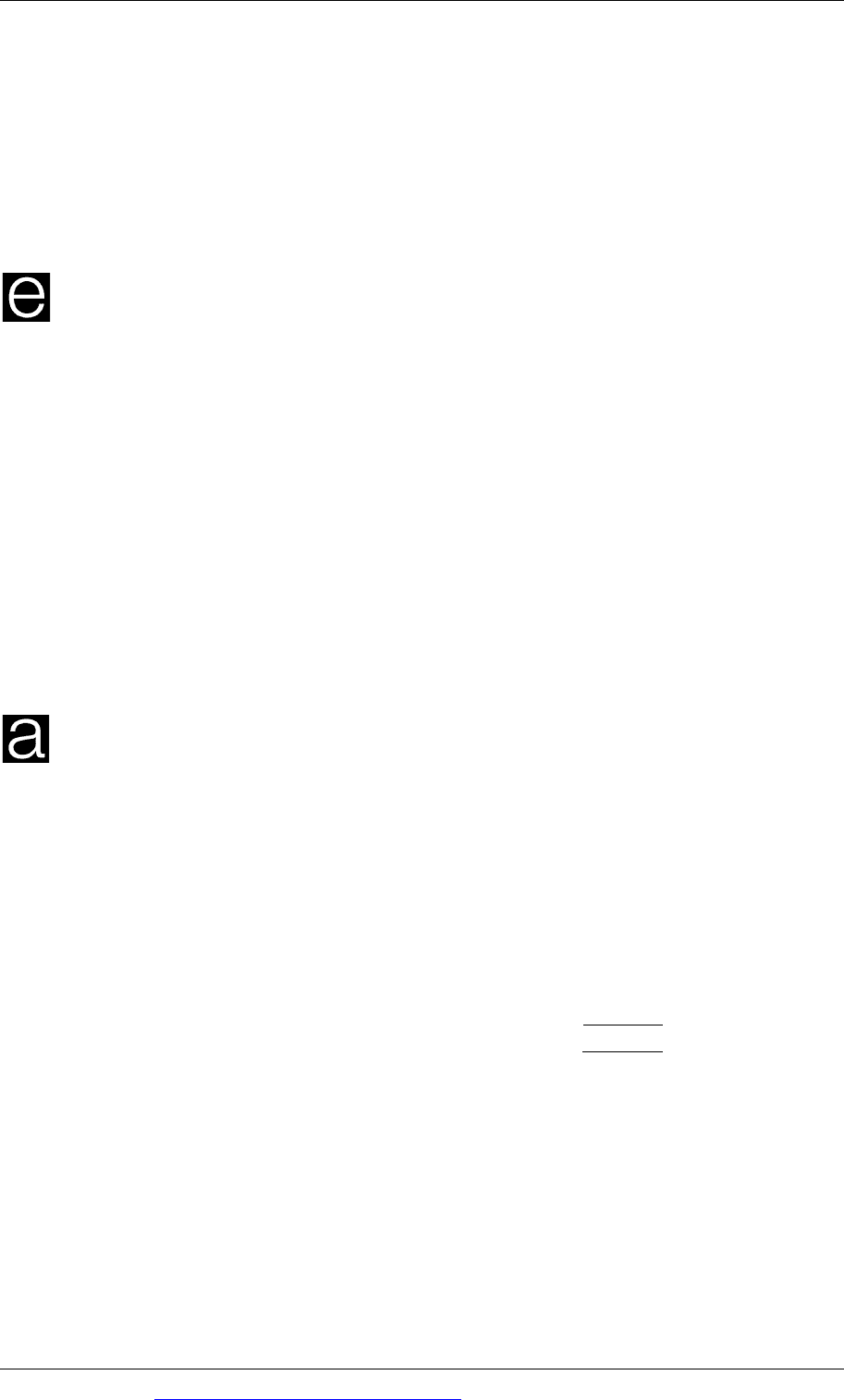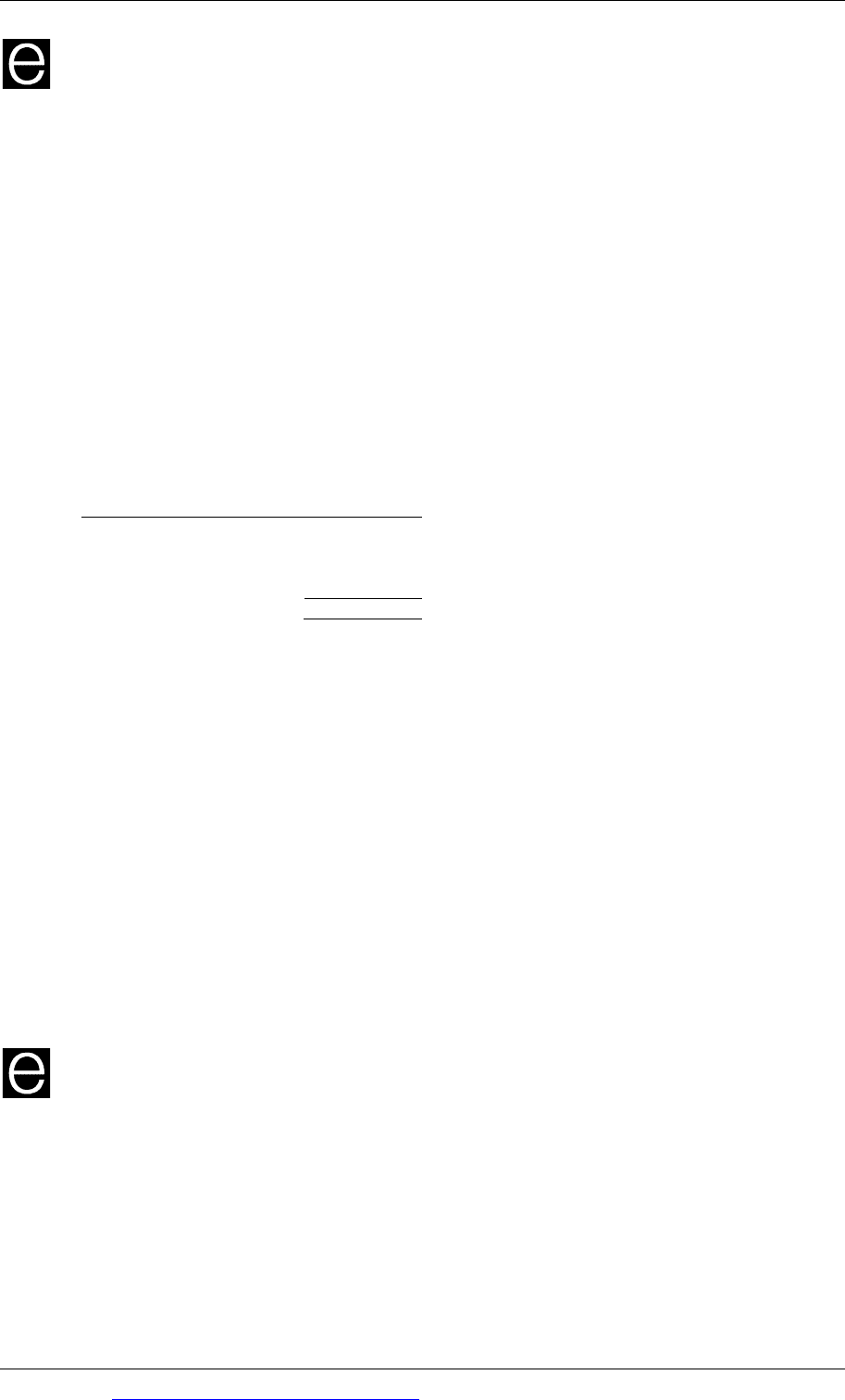ACCA P4 Advanced Financial Management - 2010 - Study text - Emile Woolf Publishing
Подождите немного. Документ загружается.


Chapter 13: Interest rate risk. Hedging with FRAs and swaps
© EWP Go to www.emilewoolfpublishing.com for Q/As, Notes & Study Guides 335
FRA rates
A bank trading in FRAs will publish indicative rates. For example, prices for sterling
FRAs might be quoted as follows:
3 v 6 5.27 – 5.23
4 v 7 5.32 – 5.28
5 v 8 5.39 – 5.34
9 v 12 5.63 – 5.56
3 v 9 5.40 – 5.36
4 v 10 5.45 – 5.41
6 v 12 5.50 – 5.45
A bank will always apply the rate that is more favourable to itself. For example, a
company wanting to fix the interest cost with a 6 v 12 FRA, using the rates in the
table above, would be quoted a rate of 5.50% for the FRA.
Notional loans and deposits
A forward exchange contract for currency is an agreement to buy and sell currency
at a future date, when there will be an exchange of currencies between the two
parties. An FRA is different. It is not an actual agreement to take out a loan or to
make a deposit. An FRA is an agreement on a notional loan or deposit, not an actual
loan or deposit. The size of the notional amount of principal (the notional loan or
deposit) is specified in the FRA agreement.
2.4 How an FRA works
An FRA works by comparing the fixed rate of interest in the FRA agreement with a
benchmark rate of interest, such as LIBOR. The comparison takes place at the
beginning of the notional interest period for the FRA.
If the FRA rate is higher than the benchmark rate (LIBOR), the buyer of the FRA
must make a payment to the seller of the FRA, in settlement of the contract
If the FRA rate is lower than the benchmark rate (LIBOR), the buyer of the FRA
receives a payment from the seller of the FRA, in settlement of the contract.
The amount of the payment is calculated from the difference between the FRA rate
and the benchmark rate (LIBOR rate), applied to the notional principal amount for
the FRA and calculated for the length of the interest period in the agreement.
Example
Suppose that a company knows that it will need to borrow £5 million in three
months’ time for a period of six months. (Alternatively, suppose that a company has
a floating rate loan of £5 million, with interest payable every six months, and the
next interest period due to start in three months’ time.)
The company can hedge its exposure to the risk of a rise in the six-month interest
rate by buying a 3 v 9 FRA for a notional principal amount of £5 million. If the

Paper P4: Advanced Financial Management
336 Go to www.emilewoolfpublishing.com for Q/As, Notes & Study Guides © EWP
bank’s FRA rates for 3 v 9 FRAs are 5.40 – 5.36, the rate applied to the agreement
will be 5.40%. The benchmark rate of interest, or ‘
reference rate’, will be the six-
month sterling LIBOR rate.
Settlement of the FRA
Suppose that at the end of month 3, six-month LIBOR is 6.25%. The FRA rate is
lower; therefore the FRA rate is settled by a payment from the bank to the buyer of
the FRA.
The difference between the FRA rate and LIBOR is 0.85%. The payment to settle
the FRA will therefore be based on an interest difference of: 0.85% × £5 million ×
6/12 = £21,250.
The actual payment will be less than this, because the FRA is settled
immediately, at the beginning of the notional interest period, and not at the end
of the period. The £21,250 is therefore discounted from an end-of-interest period
value to a start-of-interest period value, using the reference rate of interest as the
discount rate. This PV is the amount received in settlement of the FRA.
Suppose that at the end of month 3, six-month LIBOR is 4.75%. The FRA rate
(5.40%) is higher than the spot rate. Therefore the FRA rate is settled by a payment
from the buyer of the FRA to the bank. The difference between the FRA rate and
LIBOR is 0.65%.
The payment to settle the FRA will therefore be based on this interest rate
difference: 0.65% × £5 million × 6/12 = £16,250.
Again, because the payment is at the beginning of the interest period and not at
the end of the period, the £16,250 should be discounted to a present value at the
reference rate of interest. This PV is the amount of the payment in settlement of
the FRA.
How an FRA fixes a forward interest rate
Continuing the example, the company will presumably want to borrow £5 million
for six months from the end of month 3. It will do so by arranging an ordinary
short-term loan with a bank. The interest rate on the loan might be set at LIBOR +
1%.
Suppose that at the end of month 3, six-month LIBOR is 6.25%. The company
will therefore borrow for six months at 7.25%. It will receive a payment from the
FRA of 0.85%, so that the net cost of borrowing will be 6.40% (7.25% – 0.85%).
This net effective interest rate is equal to the FRA rate of 5.40% + 1%. The
company has therefore been able to fix LIBOR at 5.40% with the FRA.
Suppose that at the end of month 3, six-month LIBOR is 4.75%. The company
will therefore borrow for six months at 5.75%. However, it must also make a
payment of 0.65% to settle the FRA, bringing the total cost of borrowing for the
six months to 6.40% (5.75% + 0.65%). Again, this total effective rate is equal to
the FRA rate of 5.40% + 1% and the FRA has therefore fixed the effective LIBOR
rate at 5.40%.

Chapter 13: Interest rate risk. Hedging with FRAs and swaps
© EWP Go to www.emilewoolfpublishing.com for Q/As, Notes & Study Guides 337
Conclusion: using an FRA to hedge an interest rate risk exposure
An FRA, like a forward exchange rate, therefore fixes an interest rate in advance.
An FRA can therefore be used by a borrower to hedge an exposure to a future
increase in the spot interest rate, or to protect a depositor against a future fall in
the interest rate.
However, the user of an FRA cannot benefit from any favourable movement in
the interest rate, because the FRA fixes the rate and is a binding contract.
Example
A company has forecast that due to an expected cash shortage, it will need to
borrow $20 million for three months in two months’ time. A bank quotes the
following rates for FRAs:
2 v 3 3.61
–
3.59
2 v 5 3.67
–
3.63
3 v 5 3.68
–
3.65
Required
What would be the FRA agreement with the bank, and what rate would apply to the
agreement?
If the company can borrow at LIBOR + 50 basis points, what will be its effective rate
of borrowing for the three months if US dollar LIBOR is 4.50% at the start of the
notional interest period for the FRA?
Answer
The company needs a 2v5 FRA.
It needs to borrow; therefore the bank will quote the higher rate, 3.67.
In three months’ time on the fixing data, if US dollar LIBOR is 4.50% the bank will
pay the equivalent of (4.50% - 3.67%) = 0.83%.
%
Three-month borrowing rate (4.50% + 50 basis points 5.00
Less: settlement received in FRA agreement (0.83)
Effective borrowing rate 4.17
The effective borrowing rate is the same as the FRA rate of 3.67% plus the 50 basis
points borrowing margin that the company is required to pay on the money it
borrows: 3.67% + 0.50% = 4.17%.

Paper P4: Advanced Financial Management
338 Go to www.emilewoolfpublishing.com for Q/As, Notes & Study Guides © EWP
Interest rate swaps
The features of an interest rate swap
Swap rates
The effect of a coupon swap
3 Interest rate swaps
3.1 The features of an interest rate swap
An interest rate swap is an agreement between two parties, such as a company and
a bank that deals in swaps, for a period of time that is usually several years. Swaps
are therefore usually
long-term agreements on interest rates.
In a swap agreement, the parties agree to exchange ‘interest payments’ on a notional
amount of principal, at agreed dates throughout the term of the agreement.
The interest rate payments that are exchanged in a ‘coupon swap’ are as follows:
One party to the swap pays a fixed rate (the swap rate).
The other party pays interest at a reference rate or benchmark rate for the
interest period, such as LIBOR.
The purpose of an interest rate swap is often to:
swap a variable rate of interest payment (or receipt) into a fixed interest rate
payment (or receipt)
swap a fixed rate of interest payment (or receipt) into a variable rate of interest
payment (or receipt).
Example: ’plain-vanilla-swap’
For example, a company might arrange a four-year swap with a bank, for which the
notional principal amount is $20 million and:
the company pays interest every six months at a fixed rate of, say, 4.25%
the bank pays interest every six months at the six-month LIBOR rate for the
period.
Since both parties pay interest every six months, if the payment dates coincide, the
swap payments will simply be settled by a net payment for the difference in rates
from one party to the other.
Over the life of the four-year swap, there will therefore be eight exchanges of
interest payments. However, in an interest rate swap, there is no exchange of
principal. The interest relates to a notional amount of principal, not an actual asset
or liability.

Chapter 13: Interest rate risk. Hedging with FRAs and swaps
© EWP Go to www.emilewoolfpublishing.com for Q/As, Notes & Study Guides 339
If the six-month LIBOR rate for one of the periods is, say, 5.00%, the exchange of
payments would be settled by a payment from the bank to the company of
0.75% interest (5.00% – 4.25%) on $20 million for six months.
If the six-month LIBOR rate for one of the periods is, say, 3.00%, the exchange of
payments would be settled by a payment from the company to the bank of
1.25% interest (4.25% - 3.00%) on $20 million for six months.
The payments in a plain vanilla swap are at the end of each notional interest period,
therefore the amounts payable are not discounted (unlike an FRA).
3.2 Swap rates
Swap rates are the fixed rates that will be used by a bank in a coupon swap
agreement. Swap rates might be quoted as follows:
US dollar
Term Bid Ask
Years % %
1 year 4.03 4.06
2 years 4.17 4.20
3 years 4.29 4.32
4 years 4.63 4.66
5 years 4.91 4.94
6 years 5.14 5.17
7 years 5.33 5.36
10 years 5.73 5.76
15 years 6.16 6.19
20 years 6.35 6.38
These rates might be for a swap against three-month US dollar LIBOR. The lower
rate (the bid rate) is the rate that the bank would pay in a swap. The higher rate (the
ask rate) is the fixed rate that the bank would receive in a swap. Banks dealing in
swaps make a profit or ‘turn’ from the difference between the bid and ask rates.
Swap rates for the major international currencies are quoted for terms of up to 30
years.
3.3 The effect of a coupon swap
In a coupon swap, one party pays a fixed rate of interest and the other pays ‘the
floating’, which is the variable reference rate of interest, such as six-month LIBOR.
For a company with a loan or bonds in issue, the effect of arranging a swap can
therefore be:
to swap from fixed rate interest liabilities to floating rate liabilities, or
to swap from floating rate liabilities to fixed rate liabilities.

Paper P4: Advanced Financial Management
340 Go to www.emilewoolfpublishing.com for Q/As, Notes & Study Guides © EWP
Example
A company has a bank loan of £10 million on which it pays variable rate interest at
LIBOR + 1%. The loan has five more years to maturity. The company is worried
about the risk that interest rates will soon rise, and it wants to set a limit on its
interest costs.
It might therefore arrange a five-year swap with a bank, with interest rates to
coincide with the interest payments on its bank loan.
The bank might quote rates of 5.34 – 5.39 for a five-year swap in sterling.
The company will receive the floating rate in the swap, to offset the floating rate
payments on its bank loan. It will pay the fixed rate, and the rate will therefore be
5.39%.
The swap therefore alters the net interest payments for the company as follows:
%
Loan payments (LIBOR + 1)
Swap
Receive the floating LIBOR
Pay the fixed
(5.39)
Net interest cost
(6.39)
The company had a floating rate liability of LIBOR + 1%, and has now changed this
into a net fixed interest liability of 6.39%.
On each interest payment date, the company will pay LIBOR + 1% in interest on its
bank loan, and under the swap agreement will receive or pay the difference
between LIBOR for the period and the fixed rate of 5.39%.
You might see that an interest rate coupon swap is similar in concept to an FRA, but
is for a longer period of time and covers more than one interest period.
The company might subsequently change its mind. For example, after two years, it
might decide that it wants a floating rate liability again. If so, it can go back to a
floating rate liability by arranging with the bank to cancel the swap and agreeing a
cancellation payment (for the value of the swap at the date of cancellation).
Example
A company has 5% bonds in issue with a nominal value of 40 million euros. The
bonds have ten more years to maturity. The company wants to exchange its fixed
rate liability for a floating rate liability in euros. A bank quotes the following rate for
a ten-year swap: 4.22 – 4.25.
By arranging a swap, what will be the effective interest cost for the company?

Chapter 13: Interest rate risk. Hedging with FRAs and swaps
© EWP Go to www.emilewoolfpublishing.com for Q/As, Notes & Study Guides 341
Answer
%
Cost of the bonds (5.00)
Swap
Receive the fixed 4.22
Pay the floating (LIBOR)
Net interest cost
(LIBOR + 0.78)

Paper P4: Advanced Financial Management
342 Go to www.emilewoolfpublishing.com for Q/As, Notes & Study Guides © EWP
Using interest rate swaps
Swapping interest rate liabilities
Obtaining fixed rate liabilities
Credit arbitrage
4 Using interest rate swaps
Interest rate swaps are used to manage interest rates on liabilities (and assets, in the
case of investment institutions and banks). They can therefore be a method of
hedging exposures to interest rate risk.
4.1 Swapping interest rate liabilities
Some large companies use interest rate swaps to manage their net interest liabilities
(in each currency). For example, a company that borrows extensively, through a
combination of bank loans and bond issues, might have a policy that:
25% of its debts should be at a fixed rate
25% of its debt should be at a floating rate, and
the remaining 50% may be at a fixed or floating rate, or a mixture of fixed and
floating, depending on the judgement of the finance director or treasury
department.
The company might then use interest rate swaps to alter its net liabilities, within the
company’s policy guidelines, between fixed rate and floating rate. It might move
towards more floating rate liabilities if interest rates are expected to fall, and
towards fixed rate liabilities when interest rates are expected to rise.
The advantage of using swaps is that a company can alter its net liabilities from
fixed to floating rate or floating to fixed rate, without having to alter or re-negotiate
its actual loans or bond issues. For example, a company with fixed rate bonds can
swap from fixed to floating rate liabilities with a swap, without having to redeem
the bonds early and negotiate a floating rate loan with a bank.
4.2 Obtaining fixed rate liabilities
Many companies are unable to obtain fixed rate debt. Fixed rate interest liabilities
come from issuing bonds. Medium-term bank loans are invariably at a floating rate.
If a company is too small to issue bonds, or does not have the credit status to issue
bonds, it must borrow from banks to obtain debt finance.
If a company wants fixed rate liabilities, but can only borrow from a bank, it can
obtain a loan at a floating rate and swap into a fixed rate net liability.

Chapter 13: Interest rate risk. Hedging with FRAs and swaps
© EWP Go to www.emilewoolfpublishing.com for Q/As, Notes & Study Guides 343
Example
A company borrows from its bank for five years at LIBOR plus 150 basis points. It
wants its interest rate liabilities to be fixed, so it makes a five-year swap transaction
with a bank, in which it pays a fixed rate of 5.8% and receives LIBOR.
As a result of the swap, the company’s net interest obligations are fixed at 7.3%.
%
Loan payments (LIBOR + 1.50)
Swap
Receive the floating LIBOR
Pay the fixed
(5.80)
Net interest cost
(7.30)
4.3 Credit arbitrage
At one time, swaps were sometimes used to obtain a lower interest rate on
borrowing. This was possible because swaps banks were able to identify
opportunities for ‘credit arbitrage’. These opportunities arose because of anomalies
in the rates of interest at which different companies could borrow.
When an opportunity for credit arbitrage exists, one of the following situations will
occur:
Situation 1
Two companies want to borrow. They can both borrow at either a fixed rate or a
floating rate. Company A has to pay a higher rate of interest than Company B.
However, the difference in borrowing costs between the two companies is less for
fixed rate borrowing than for variable rate borrowing.
For example:
Fixed rate
borrowing cost
Variable rate
borrowing cost
Company A 7.25%
LIBOR + 1.5%
Company B 6.50%
LIBOR + 0.5%
Difference 0.75%
1.0%
Credit arbitrage is possible using an interest rate swap if Company A wants to
borrow at a variable rate of interest and Company B wants to borrow at a fixed rate.
Situation 2
Two companies want to borrow. They can both borrow at either a fixed rate or a
floating rate. Company C has to pay a higher rate of interest than Company D.
However, the difference in borrowing costs between the two companies is more for
fixed rate borrowing than for variable rate borrowing.

Paper P4: Advanced Financial Management
344 Go to www.emilewoolfpublishing.com for Q/As, Notes & Study Guides © EWP
For example:
Fixed rate
borrowing cost
Variable rate
borrowing cost
Company C 7.75%
LIBOR + 1.5%
Company D 6.50%
LIBOR + 0.5%
Difference 1.25%
1.0%
Credit arbitrage is possible using an interest rate swap if Company C wants to
borrow at a fixed rate of interest and Company B wants to borrow at a variable rate.
Example
A bank is aware that two companies can borrow at the following rates:
Fixed Floating
Company A 5.50% LIBOR + 0.50%
Company B 6.40% LIBOR + 1%
Company A wants to borrow at a floating rate, and can do so at LIBOR + 0.50%.
Company B wants to borrow at a fixed rate, and can do so at 6.40%. However, an
opportunity for credit arbitrage exists, because company A can borrow at a fixed
rate 0.90% less than company B, but at a floating rate only 0.50% less than company
B. The opportunity for credit arbitrage totals 0.40% (0.90% - 0.50%).
A bank might therefore propose the following arrangement:
Company A should borrow at a fixed rate, by issuing bonds at 5.50%. Company
B should borrow at a floating rate, by obtaining a bank loan at LIBOR + 1%.
Company A should enter into a swap with the bank in which it receives 5.20%
fixed and pays LIBOR.
Company B should enter into a swap with the bank in which it pays 5.25% fixed
and receives LIBOR.
The net interest cost of each company would be as follows:
Company A Company B
% %
Borrowing cost
(5.50)
(LIBOR + 1)
Swap
Receive 5.20
LIBOR
Pay (LIBOR)
(5.25)
Net cost (LIBOR + 0.30)
(6.25)
Company A reduces its net borrowing cost by 0.20% below the cost of borrowing
directly at a floating rate, and company B reduces its fixed rate cost by 0.15% below
the cost of issuing bonds at 6.40%. The bank makes a profit of 0.05% from the
difference between its fixed rates in the swap for receiving (5.25% from company B)
and paying (5.20% to company A).
